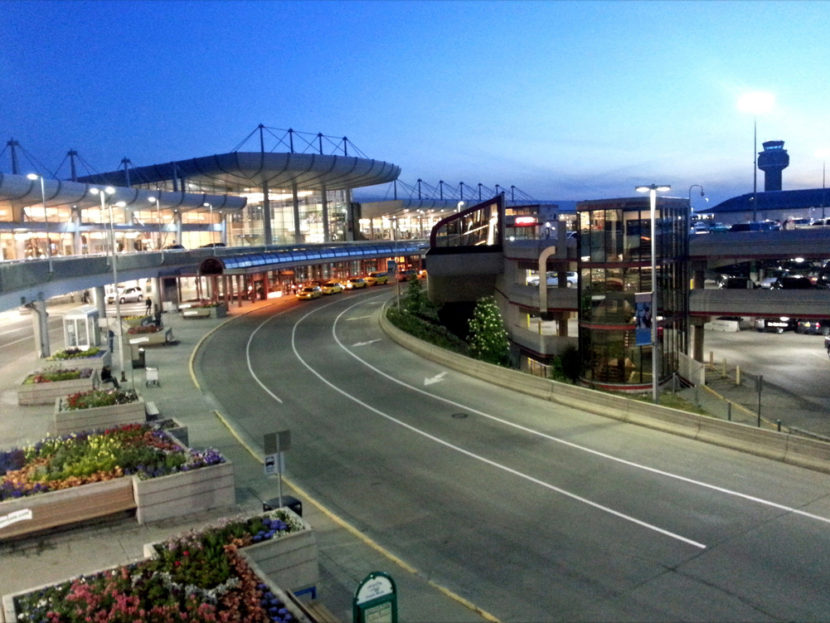
The 12-story air traffic control tower at Anchorage’s main airport is normally one of the best offices in town, with sweeping views of Cook Inlet, Denali and the Chugach Mountains.
On Friday morning, though, Anchorage’s 7.0 earthquake reminded controllers that their workplace rests atop a “150-foot toothpick,” said Clint Blaszak, a supervisor in the tower.
After evacuating, the controllers, who work for the Federal Aviation Administration, first headed for their backup location, the airport fire station.

But that building was closed to them, too, because of possible damage. So Blaszak and two colleagues went with Plan C: guiding in planes at the nation’s fifth-busiest cargo hub from the cab of a pickup truck, at one end of the north-south runway.
Their improvised response, with help from some quick-moving runway inspectors, meant that the airport’s three runways were closed for less than 10 minutes, officials said.“Most of our equipment is windows. We had a window in the truck,” Blaszak said in an interview atop the tower Saturday. “Everybody had a radio. Everybody had a phone.”
Alaska Airlines diverted just two planes – one to Fairbanks and one that returned to Portland – and canceled just four flights that day, Marilyn Romano, the company’s regional vice president, said in an email.
Damage to the airport’s terminal did disrupt passenger traffic somewhat, and Romano said that Alaska Airlines had to pause its operations for a safety check.
But cargo traffic continued moving largely unabated, according to airport officials. And the earthquake could have caused a much bigger logistical mess if the controllers were knocked offline for long, said Sherri LaRue, associate professor of aviation technology at University of Alaska Anchorage.
“It’s an extraordinary situation. I give them a lot of credit,” LaRue said.

In Anchorage’s huge 1964 earthquake, the airport tower actually collapsed and one person died.
This time, Blaszak, 38, said the building swayed three or four feet, and he described watching transformers blow out around town during the pre-dawn earthquake. A coffee pot was knocked from its perch, and even Saturday morning, the platform was still missing some ceiling tiles.
In a break room one floor down, Patrick Beargie said he put a pillow over his head as locker tipped over, a fire extinguisher ripped out of the wall and a refrigerator rolled halfway across the room.
“It was just stuff, everywhere. The contents of everything just thrown all over the floor,” he said.
Immediately afterward, the tower controllers aborted an imminent landing by a FedEx jet. Their dramatic radio transmissions – “FedEx, go around, FedEx, go around!” – were captured in an audio recording subsequently replayed on news broadcasts.
Once the magnitude of the earthquake became clear, the controllers all evacuated. Blaszak headed down the spiral staircase from the observation deck carrying a pair of radios.The airport’s three runways needed to be inspected for cracks before they could reopen, which airport manager Jim Szczesniak said took about eight minutes.
Inside the truck, he said, the three controllers split up their duties. One worked the runways and taxiing, a second worked with another group of controllers that handle planes farther from the airport and a third coordinated.
Blaszak stressed that they relied on dozens of FAA employees at other locations.
Working from a truck isn’t completely unprecedented – controllers sometimes operate from trucks or tents or trailers during emergencies, or in the military. The Seattle airport built a temporary tower out of shipping containers after a 2001 earthquake destroyed the previous version.
The job demands a certain amount of improvisation, according to LaRue, the Anchorage aviation professor.
“Obviously, there are rules and you’re supposed to follow them, so you’d never say you’re supposed to be super creative,” she said. “But not everything is covered by a rule.”
If the controllers hadn’t been able to set up from the truck, experts said it probably wouldn’t have been an immediate safety risk to planes and passengers.
Without controllers, pilots can – and did – use a system called common traffic advisory frequency, or CTAF, that calls for them to announce their own positions and movements. But that’s far less efficient than instructions from the airport tower – LaRue compared it to relying on a four-way stop sign instead of a stop light.
Szczesniak, the airport manager, credited the quick-thinking controllers and speedy runway inspectors with keeping things moving.
“If I looked out the windows, it was like nothing happened as far as air traffic was concerned,” he said. “They were continuing to land and depart and land and depart, just like they would normally.”
In the aftermath of the earthquake, Blaszak said the controllers are reassessing their backup plans, given that their original Plan B – the fire station – turned out to be inaccessible.




